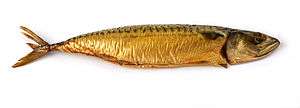Mackerel as food


| Nutritional value per 100 g (3.5 oz) | |
|---|---|
| Energy | 858 kJ (205 kcal) |
|
13.89 g | |
|
18.60 g | |
| Vitamins | |
| Vitamin A | 167 IU |
| Vitamin D |
(107%) 643 IU |
| Minerals | |
| Calcium |
(1%) 12 mg |
| Iron |
(13%) 1.63 mg |
| Magnesium |
(21%) 76 mg |
| Phosphorus |
(31%) 217 mg |
| Potassium |
(7%) 314 mg |
| Sodium |
(6%) 90 mg |
| Zinc |
(7%) 0.63 mg |
| Other constituents | |
| Water | 63.55 g |
| |
|
Percentages are roughly approximated using US recommendations for adults. Source: USDA Nutrient Database | |
Mackerel is an important food fish that is consumed worldwide.[1] As an oily fish, it is a rich source of omega-3 fatty acids.[2] The flesh of mackerel spoils quickly, especially in the tropics, and can cause scombroid food poisoning. Accordingly, it should be eaten on the day of capture, unless properly refrigerated or cured.[3]
Mackerel preservation is not simple. Before the 19th-century development of canning and the widespread availability of refrigeration, salting and smoking were the principal preservation methods available.[4] Historically in England, this fish was not preserved, but was consumed only in its fresh form. However, spoilage was common, leading the authors of The Cambridge Economic History of Europe to remark: "There are more references to stinking mackerel in English literature than to any other fish!"[5] In France mackerel was traditionally pickled with large amounts of salt, which allowed it to be sold widely across the country.[5]
In Japan mackerel is commonly cured with salt and vinegar to make a type of sushi known as saba-zushi. Historically saba-zushi originated in Kyoto as a solution for transporting mackerel to the inland city, which otherwise would not have made the journey from the coast still fresh.[6]
There is a large variation in the mercury levels found in mackerel. These levels differ markedly for different species, and even for the same species in different locations; however, the strongest positive correlation seems to be connected to the species' size (the larger species being higher on the food chain).[7] According to the United States Food and Drug Administration, king mackerel is one of four fishes, along with swordfish, shark, and tilefish, that children and pregnant women should avoid due to high levels of methylmercury found in these fish and the consequent risk of mercury poisoning.[8][9]
| Comparative mercury levels[10] | |||||||
|---|---|---|---|---|---|---|---|
| Species | Mean ppm | ||||||
| Tilefish | 1.450 | Gulf of Mexico | |||||
| Swordfish | 0.995 | ||||||
| Shark | 0.979 | ||||||
| King mackerel | 0.730 | ||||||
| Bigeye tuna | 0.689 | Fresh/frozen | |||||
| Atlantic Spanish mackerel | 0.454 | Gulf of Mexico | |||||
| Spanish mackerel | 0.182 | South Atlantic | |||||
| Chub mackerel | 0.088 | Pacific | |||||
| Herring | 0.084 | ||||||
| Flatfish * | 0.056 | Flounder, plaice and sole | |||||
| Atlantic mackerel | 0.050 | ||||||
| Catfish | 0.025 | ||||||
| Salmon * | 0.022 | Fresh/frozen | |||||
| Sardine | 0.013 | ||||||
| Tilapia * | 0.013 | ||||||
| * indicates methylmercury only was analyzed (all other results are for total mercury) | |||||||
| More images |
|---|
   |
Notes
- ↑ Croker, Richard Symonds (1933). The California mackerel fishery. Division of Fish and Game of California. pp. 9–10.
- ↑ Jersey Seafood Nutrition and Health, State of New Jersey Department of Agriculture, retrieved 6 April 2012
- ↑ Scombrotoxin (Histamine) Food Safety Watch, November 2007.
- ↑ Croker (1933), pages 104–105
- 1 2 Clapham JH, Postan MM and Rich EE (1941) The Cambridge economic history of Europe CUP Archive, pp. 166–168. ISBN 978-0-521-08710-0.
- ↑ Itou K, Kobayashi S, Ooizmi T and Akahane Y (2006) "Changes of proximate composition and extractive components in narezushi, a fermented mackerel product, during processing" Fisheries Science, 72(6): 1269–1276. doi:10.1111/j.1444-2906.2006.01285.x
- ↑ Storelli MM, Barone G, Piscitelli G, Marcotrigiano GO (2007). "Mercury in fish: concentration vs. fish size and estimates of mercury intake.". Retrieved 15 October 2016.
- ↑ FDA (1990–2010). "Mercury Levels in Commercial Fish and Shellfish". Retrieved 14 September 2011.
- ↑ Natural Resources Defense Council. "Protect Yourself and Your Family". Retrieved 14 September 2011.
- ↑ The mercury levels in the table, unless otherwise indicated, are taken from: Mercury Levels in Commercial Fish and Shellfish (1990–2010) U.S. Food and Drug Administration. Accessed 8 January 2012.
Other references
- Keay JN (2001) Handling and processing mackerel Torry advisory note 66.
External links
| Wikimedia Commons has media related to Mackerel dishes. |



